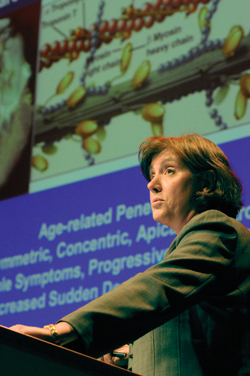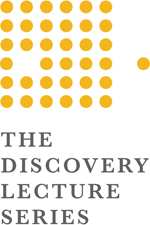
Harvard’s Christine Seidman, M.D., speaks at last week’s Discovery Lecture. (photo by Mary Donaldson)
Speaker outlines hunt for genetic clues to heart disorder

Deciphering the genetics of a complex disease is a bit like counting the stars.
Fortunately, the last few years have seen the emergence of incredible new tools and techniques, notably gene sequencing methods, which make such counting possible.
During the James C. Overall Discovery Lecture at Vanderbilt University Medical Center last week, Christine Seidman, M.D., described techniques she and her Harvard colleagues have developed for identifying the genetic contributors to cardiovascular disease.
One of their targets: hypertrophic cardiomyopathy (HCM), a mysterious enlargement of the heart that can trigger sudden and unexpected death — even in otherwise healthy athletes.
Last year an echocardiogram detected the condition in University of Tennessee basketball standout Duke Crews. While the sophomore forward has been cleared to play, the exam possibly saved his life, his mother told the Associated Press last week.
An estimated 3 percent to 4 percent of Americans have unexplained cardiac hypertrophy, said Seidman, a professor of Medicine and Genetics at Harvard Medical School and an investigator of the Howard Hughes Medical Institute who directs the Cardiovascular Genetics Service at Brigham and Women's Hospital.
For the past decade, she and her colleagues, including her husband, Jonathan Seidman, Ph.D., a professor of Genetics at Harvard, have studied the genetics of HCM and other cardiovascular diseases.
Applying novel gene sequencing techniques including PMAGE (polony multiplex analysis of gene expression) to a mouse model of HCM, they've been able to identify mutations in “multiple different pathways” that affect heart function.
While the research may lead to better diagnosis and earlier detection of HCM, the ultimate goal, said Seidman, is to find ways to stop the condition — or prevent it from occurring in the first place.
“If we are going to prevent hypertrophic remodeling (of the heart), we not only need to make an accurate diagnosis, but we need to be able to intervene,” she said. “Personalized medicine is going to be very personalized.”
For a complete schedule of the Discovery Lecture Series and archived video of previous lectures, go to www.mc.vanderbilt.edu/discoveryseries.













